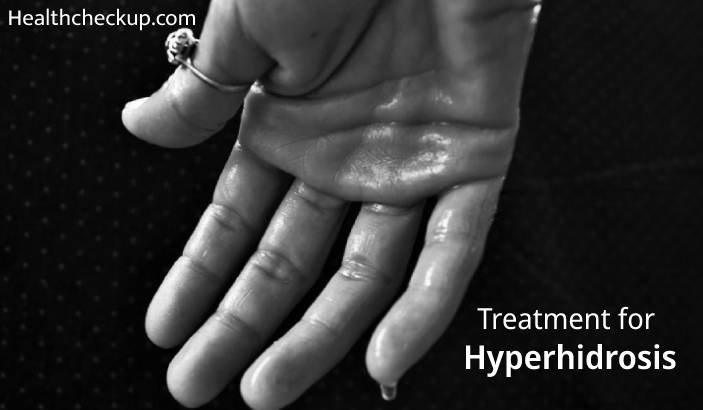Hyperhidrosis is characterized by excessive sweating not linked to the external temperature or strenuous activity. It affects daily activities and results in social disengagement and embarrassment. The hyperhidrosis may have a genetic component involved (primary hyperhidrosis) or is due to underlying medical conditions (secondary hyperhidrosis), such as thyroid disorders, diabetes, low blood sugar, infections, and disorders of the nervous system. If patients experience symptoms, they should consult a doctor to treat hyperhidrosis. There are several hyperhidrosis treatments.
If you are looking for Hyperhidrosis treatment options near you, check these out..
There are several treatments for hyperhidrosis. Some of the most common ones are:
- Medications:
Several medications are prescribed to the patients to reduce sweating. These medications reduce glandular secretions and work throughout the body. These medications include anticholinergics, such as benztropine and oxybutynin. Side effects of these medications are dry mouth, dry eyes, and blurred vision. Some patients may also receive benzodiazepine and propranolol, which reduces excessive sweating due to stressful situations. These medications block the physiological changes that occur due to stress. - Antiperspirants:
Antiperspirants are considered the first-line treatment for hyperhidrosis recommended by dermatologists. There are no systemic exposures and thus have fewer or no side effects. The dermatologist may prescribe either a regular or a clinical antiperspirant, depending upon hyperhidrosis severity. As the body sweats, the antiperspirants enter the sweat glands and plug them. As the body senses the blockage of the sweat glands, it signals to reduce the secretion of the sweat. As a result, some people may experience irritated skin or a burning sensation. - Creams:
The doctor may also prescribe creams that may help manage the symptoms of hyperhidrosis. The cream contains glycopyrrolate and is useful in patients with excessive sweating on the head and face. - Injections:
Botox for hyperhidrosis have beneficial effects. The nerve that causes sweating is temporarily blocked by the Botulinum injection. The injection is administered under the effect of anesthesia. The doctor injects the Botulinum at each affected site. The duration of action of the injection is about six to twelve months. The treatment may be repeated. Patients may experience pain and temporary muscle weakness. - Topical wipes:
The topical cloth wipes have been approved by the USFDA in patients of age nine years or older suffering from excessive sweating in the underarms. These cloths contain glycopyrronium tosylate, which helps in reducing sweat. One wipe per day to treat the underarms is enough for most patients. The patients may experience redness, dry mouth, and burning and stinging sensation. - Iontophoresis:
This procedure treats hyperhidrosis of the hands and feet. The patients may need to undergo weekly sessions of treatment. The doctor performs the procedure with the help of a machine that generates a low-voltage current. The patients immerse the feet or hands in the trough, and the current is passed. For other body areas, patches connected to the machine are placed on the affected area. The procedure temporarily shuts the sweat glands. - Microwave therapy:
This procedure uses the device that generates the microwaves. The microwave damages the sweat glands and manages the symptoms of hyperhidrosis. The patients need to take the treatment two times within three months. Each session is around 20 to 30 minutes. The patients may experience a mild discomfort and changes in the sensation of the skin. - Nerve surgery:
Sweat glands are controlled by the nerves. During the nerve surgery, the surgeons either burn, clamp or cut the nerves that control sweat production in the hands. It helps in managing sweaty palms. However, in some cases, other body areas may have excessive sweating as a compensatory mechanism. This procedure is not generally used to reduce the sweating of the head and neck. - Removal of sweat glands:
Hyperhidrosis surgery also involves the removal of the sweat glands. It is usually performed in patients who suffer from hyperhidrosis limited to the armpits. In some patients in whom the other options are ineffective, the doctor may also perform a minimally invasive technique known as suction curettage. - Home remedies:
Several home remedies may also help the patients manage hyperhidrosis symptoms. The patients must take a bath regularly and opt for socks made of natural materials. The clothes should allow the body to breathe. Some relaxation techniques, such as meditation and yoga, may also help relieve anxiety and hyperhidrosis symptoms.
Conclusion
There are several ways to reduce the symptoms of hyperhidrosis. Hyperhidrosis treatment options include medications, injections, surgeries, and wipes. Treatment of hyperhidrosis also involves home remedies and antiperspirants.

Rohit Jain is an IPR Specialist and Medical Content Writing Expert. For over a decade, he has written several articles in the areas of female infertility, Erectile dysfunction, hemangioma, cervical cancer, monoclonal gammopathy of undetermined significance, mononucleosis, mitral valve disorder, nerve sheath tumor, shin splints, mild cognitive impairment, cellulitis, brain metastases, atelectasis, MCAD deficiency, lymphoma, sepsis, cardiac rehabilitation and metabolic disorder among others.









